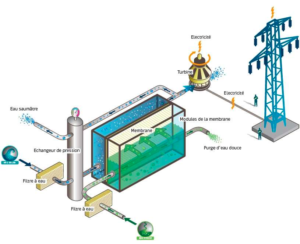
Nearly three years after the launch of the first osmotic power plant in Norway, two researchers are taking stock of this technology by analyzing its efficiency and the potential of the industry. The results are encouraging. Nearly half a billion people could eventually consume this electricity produced from freshwater and seawater without any gram of CO 2 being emitted.
The town of Tofte, Norway, has been home to a new generation power station since 2009. It does not consume fuel and, above all, does not release greenhouse gases into the atmosphere . How is it possible ? Because this infrastructure exploits the salinity gradient between freshwater and seawater through a process called Pressure retarded osmosis or PRO. It produces a so-called osmotic energy .
The fresh and salty waters are separated by a semi-permeable membrane . To rebalance the solute concentrations on either side of this porous structure, a spontaneous stream of water flows through it, from the river water (low in salt) to the seawater, thus causing an increase pressure in the receiving compartment. It is a simple application of the principle of osmosis . The overflow of water is then evacuated, not without having first actuated a turbine connected to a current generator . The pressure of the salt compartment may reach the equivalent of a water column ( ie of) 120 meters high!
This type of installation can not be built anywhere since at least you need to have access to two water sources with different solute concentrations. The mouths are therefore sites of choice … and our planet is home to thousands. Three years after the launch of this project by the firm Statkraft , the time is at first balance. Ngai Yin Yip and Menachem Elimelech of Yale University (USA) have re-evaluated the potential and effectiveness of this process in a new study. Their results are published in the journal Environmental Science & Technology.
Osmotic energy: efficient and profitable on a large scale
This plant exploits the free energy (called Gibb) lost when the fresh water is diluted at sea . Its theoretical value can be calculated and therefore serve as a reference to describe the efficiency of the process. According to this model, the pressure retarded osmosis would extract up to 0.75 kWh of energy per m 3 of water (at constant pressure). This value represents 91.1% of the theoretically available energy quantity, ie 0.81 kWh per m 3 . This result is more than acceptable.
Other figures cited in this study are important. According to the two researchers, the exploitation of only one-tenth of the waters flowing into the oceans at the scale of the Planet would provide a sustainableresponse to the electricity needs of 520 million people, all without releasing a single tonne of CO 2 . For similar production, coal-firedpower plants release more than one billion tonnes of carbon dioxide into the atmosphere. The osmotic energy seems to have a good future.
